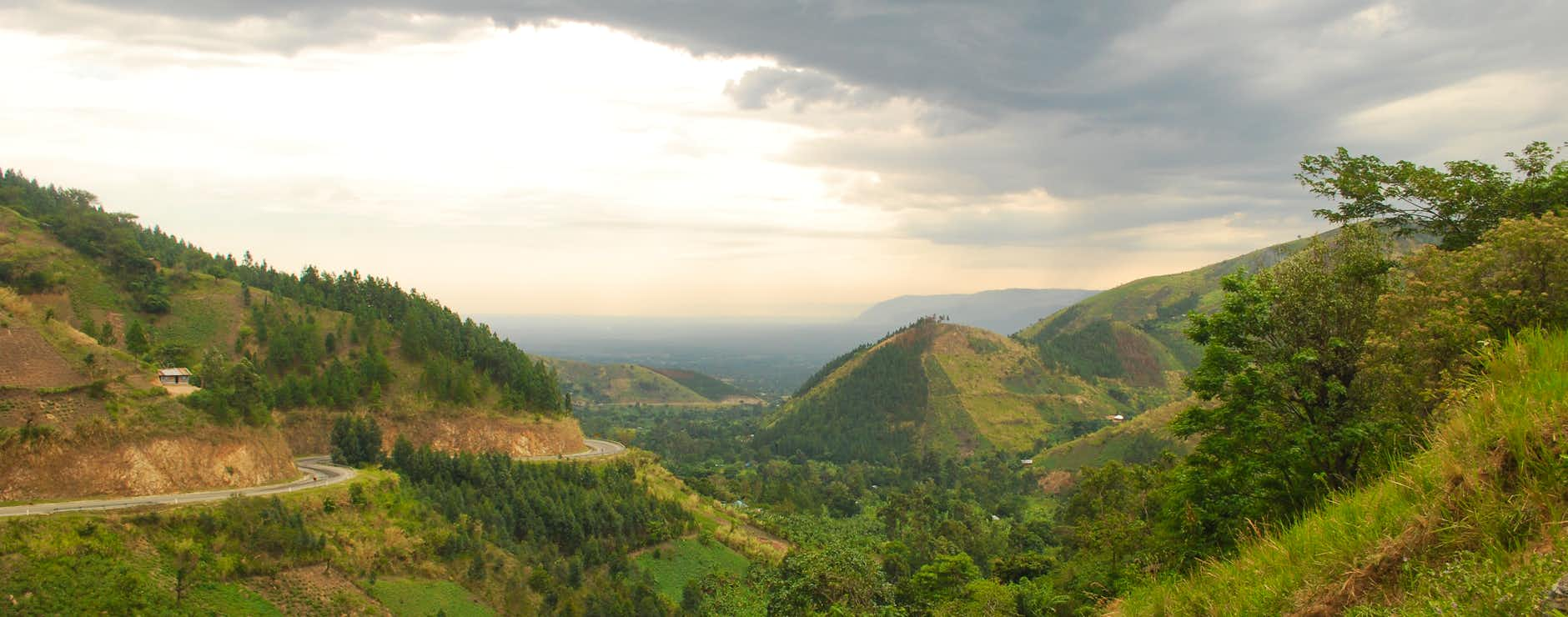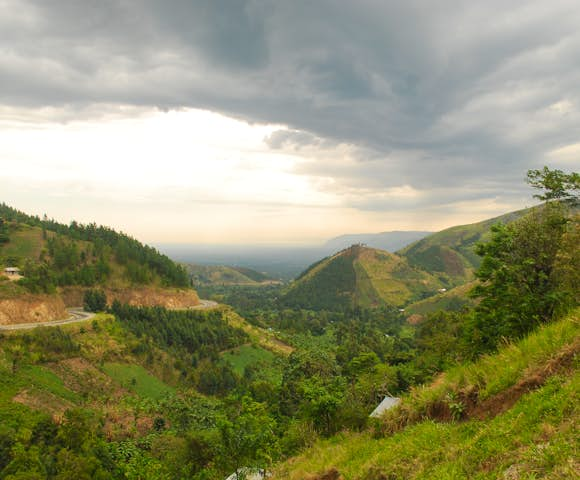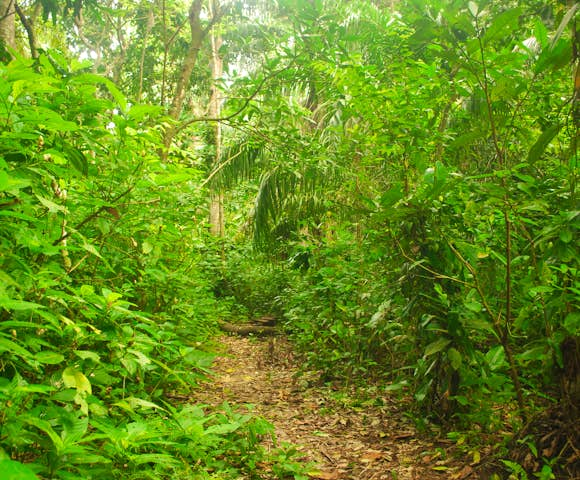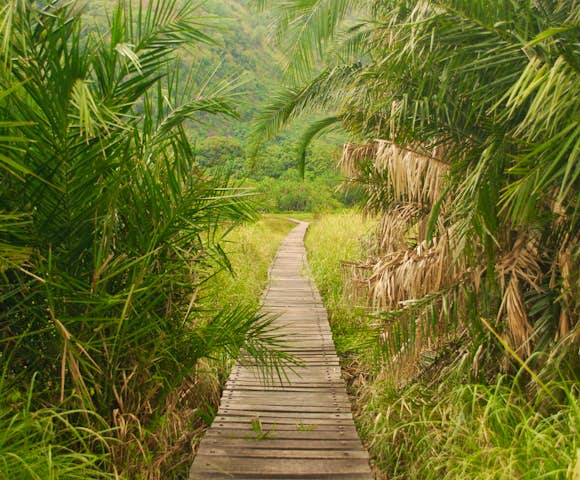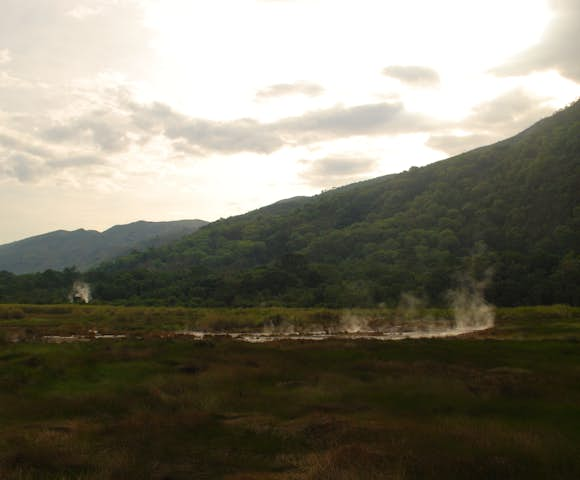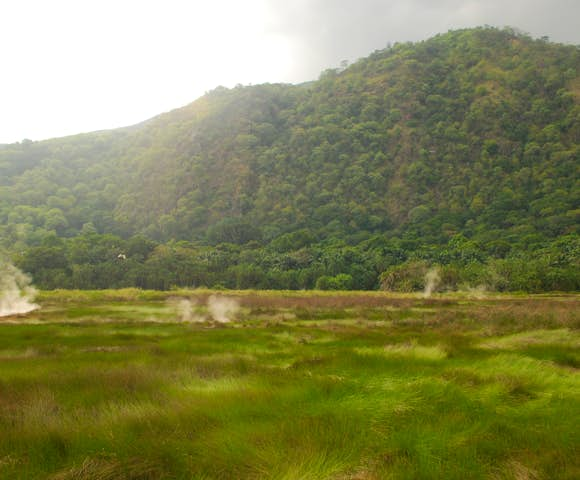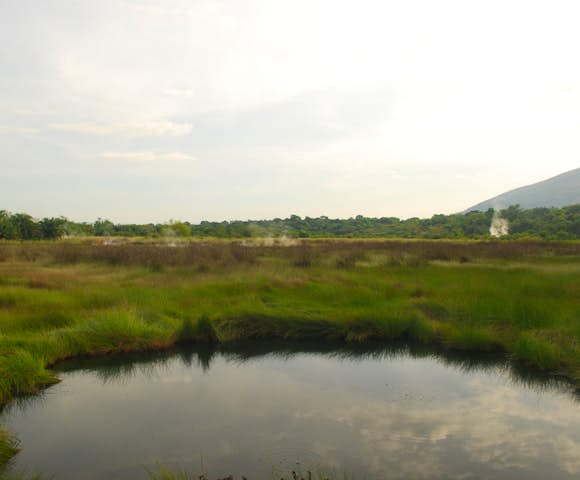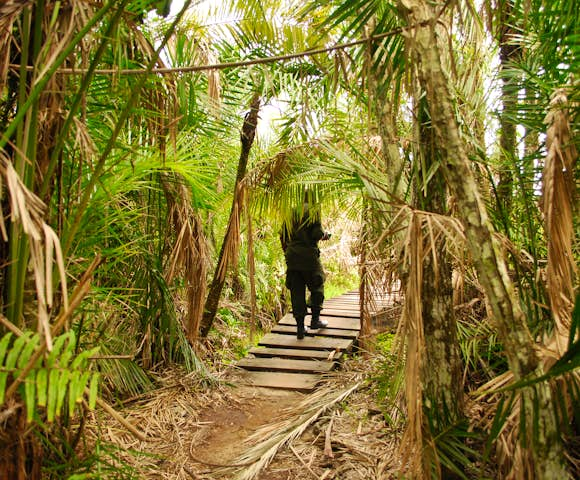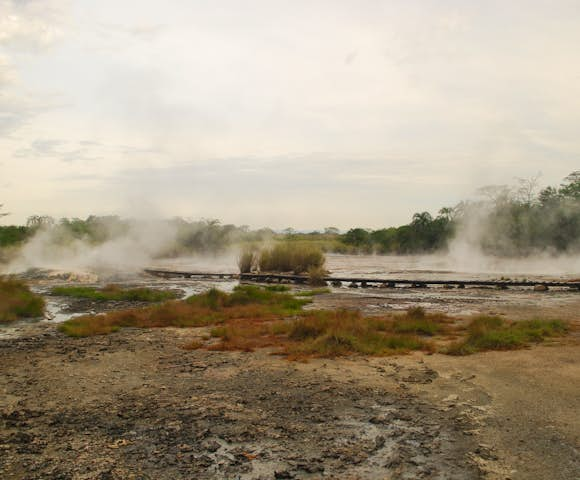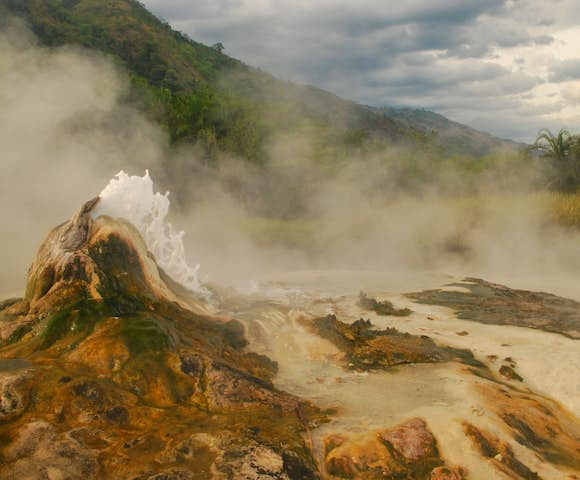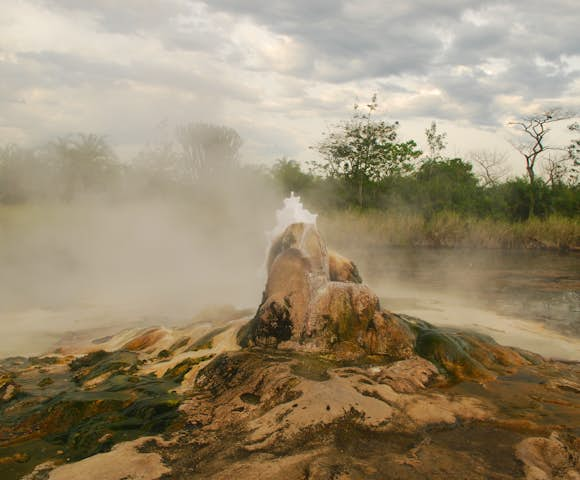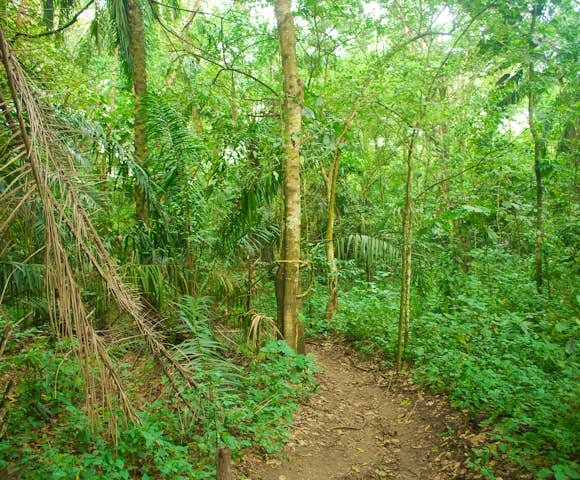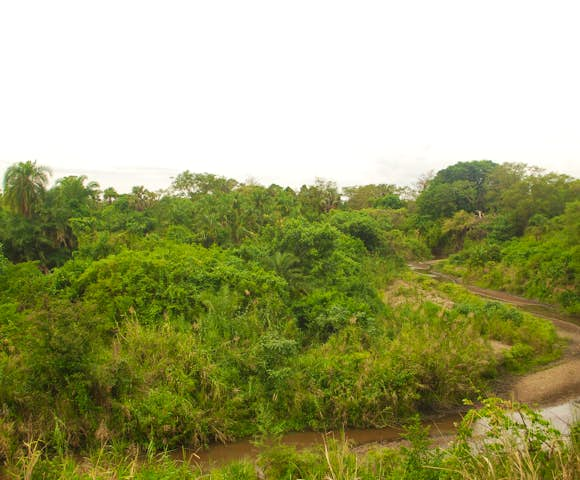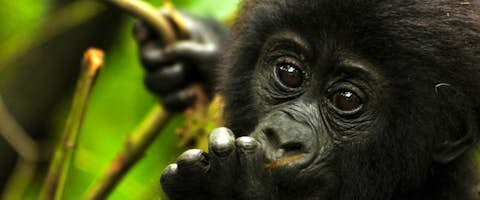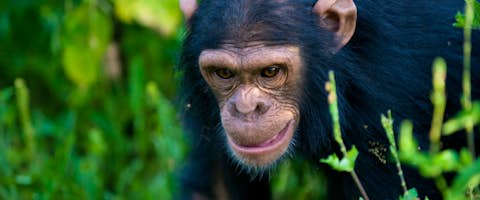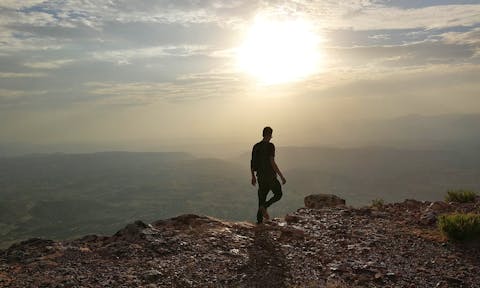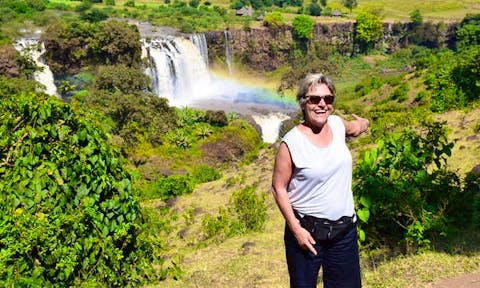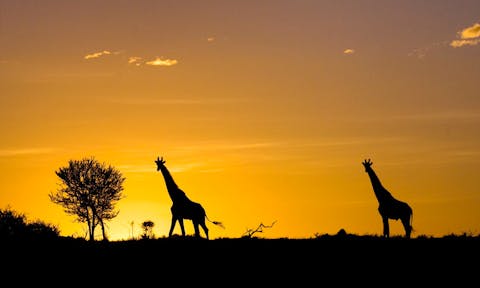Introducing the Semliki Valley
Uganda’s first protected area, the Semliki Valley lies on the border with the DRC, south of Lake Albert, below the Kijura Escarpment and the northern foothills of the Rwenzori Mountains.
It is a wonderfully remote introduction to the habitats of Central Africa without having to leave Uganda. The forests of the national park are the eastern-most extension of the Ituri Forest of the Congo Basin and is the only true lowland tropical forest in East Africa.
The valley draws those wanting to experience the best of Uganda, while avoiding the more famous, busier, parts of the country. It is also a prime birding destination. Semuliki National Park has 441 recorded bird species, representing 40% of the species found in Uganda and 66% of the country’s forest species.

Semliki Valley offers a taste of central Africa within Uganda's borders.
The national park can only be explored on foot, and there are a number of guided trails that take visitors through the ancient forests, papyrus swamps and hot springs.
Beyond the park lies the Semliki Wildlife Reserve, a contrasting area of open savanna grassland and riverine forest. Where the park is dark and tangibly ancient, the reserve has a gentle beauty, only enhanced by the low number of visitors.
First protected in 1926 due to its important population of Ugandan kob, it is also home to a dry habitat chimpanzee community, colobus monkeys, buffalo and both forest and savannah elephant.

Semliki has suffered from high levels of poaching historically and so mammal numbers are low compared to other savannah parks in Uganda, but it is an excellent example of conservation in action. If you are interested in the challenges of African conservation as well as enjoying wildlife sightings, then Semliki is perfect for you.
The reserve also has 425 recorded bird species. The boat safaris operated on Lake Albert from the reserve are one of the best ways to see Shoebill stork in Uganda. Sightings are frequent, the entire experience is beautiful and the only people you are likely to see are fishermen working the waters of Lake Albert.
Semliki is also a lovely place in which to simply relax, enjoying the peace of this secluded part of Uganda.

Things to do in Semliki Valley
Semuliki National Park Walking Trails
Exploring this unique forest habitat is a very special experience for both birders and visitors looking for atmospheric locations of international scientific importance.
There are three trails that can be explored in the company of a Uganda Wildlife Authority Guide. The longest is the 13km Kirumia Trail, which takes you through the heart of the forest to the Semuliki River. The transect through different habitats makes this perfect for birders. Expect to be out for 8 hours.
Slightly shorter at 11km, the Red Monkey trail follows the park’s eastern border to the Semliki River with the aim of sighting the rare deBrazza’s monkey, which is often seen in this area.
The shortest trail is the 8km (at its full length) Sempaya Nature Trail. It introduces visitors to the forest with its primates and takes you to the hot springs. The hike lasts between 2 and 4 hours and can take place in the morning or afternoon.

Semuliki National Park Hot Springs
Even if you don’t want to follow a longer forest trail, the hot springs are worth a visit.
Accessed via a short boardwalk (in parts) trail through the forest, there are two springs called the ‘Male’ and ‘Female’ springs. A visual testament to the geologic forces that formed the valley, they also have a lot of cultural significance locally.
Your guide will share the stories with you. This is a lovely half day excursion from Semliki Safari Lodge.

Semliki Wildlife Reserve Game Drives
The Semliki Wildlife Reserve can be explored on three game drive tracks.
Game drives are either operated by Uganda Wildlife Authority or Semliki Safari Lodge. They operate in the morning and late afternoon.
Night game drives are also available. Smaller forest and larger savannah elephants are regularly seen, along with buffalo, waterbuck, crocodile, warthog and Uganda kob.
Also look for pygmy hippo, leopards and noisy bushbabies.
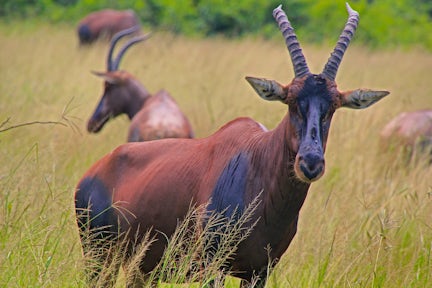
Semliki Wildlife Reserve Primate Walk
The chimpanzee population in Semliki is of particular scientific interest because it occupies a drier habitat than those found in Kibale, Budongo or Kyambura. This means they range further to locate their food and have been observed walking on their hind legs for short distances.
The population is currently subject of a long-term habituation project. You can join the researchers on a primate walk, but do not necessarily expect to see the chimps because they can move far and quickly. Instead, it is an opportunity to discover more about a fascinating species whilst exploring a beautiful environment.

Hanging out with the chimps on their turf is an unforgettable experience.
Semliki Wildlife Reserve Nature Walk
Explore the reserve with no end goal in mind on a 3-hour amble through a variety of habitats ranging from savannah woodland to riverine forest.
Expect to encounter: Ground Hornbills, Warthogs, Uganda Kobs, baboons, Black and White Colobus and Vervet Monkeys.
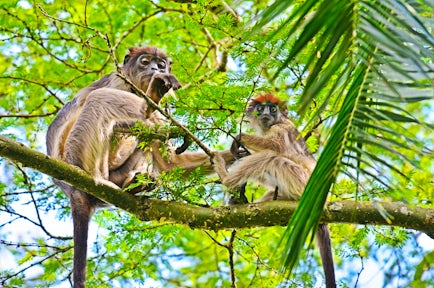
Chimps share the forest with other primate species.
Lake Albert Shoebill boat safari
Take to the mirror-like (on a still day) waters of Lake Albert to look for the sought after Shoebill stork.
Best seen on the borders of the papyrus beds that mark where the Semliki river enters Lake Albert, this wonderful encounter is made all the more special by the boat trip across the lake and the stunning back-drop of the hazy blue mountains of the DRC.
The best boat safari is enjoyed in the morning and operated by Semliki Safari Lodge.
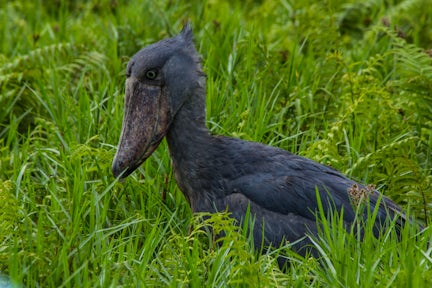
The Mabamba Swamp is home to the famous shoebill stalk.
Places to stay in the Semliki Valley
The Semliki Valley can be visited by anyone staying in the lodges and hotels at Fort Portal - or even Kibale if you don’t mind the time on the road. However, it is best enjoyed by spending a few nights at the wonderful Semliki Safari Lodge.
The only lodge within the reserve, it manages to combine a little deserved luxury with old-fashioned style and charm. 8 en-suite tents, with beautiful hardwood floors, host a maximum of 18 guests.
The main lodge has been perfectly designed to provide comfort and foster friendships, and the food is excellent. Both the main lodge and tents provide delightful views of the riverine valley and the Rwenzori Mountains beyond. Oh, and did we mention the swimming pool?
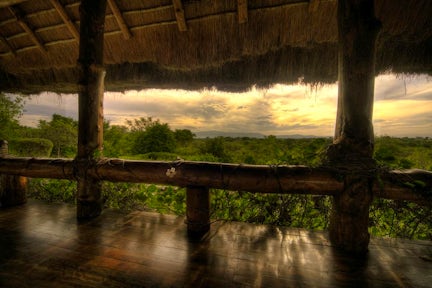
Luxury travel means experiencing the nature in comfort and style.
Geography & Geology of the Semliki Valley
Located on the remote western side of the Rwenzori Mountains, the Semuliki National Park and the Semliki Wildlife Reserve (formerly the Toro-Semliki Game Reserve) combine to protect the habitats of much of the Semliki Valley.
Semuliki National Park is 220 kilometres squared and 670-760 metres above sea level. Initially protected as a Forest Reserve in 1932, it was upgraded to a National Park in 1993. Its forest forms the eastern limit of the Great Ituri Forest of the DRC and, as such, is the only true tract of lowland tropical forest in East Africa. The hot sulphur springs still hold great local significance for the local communities bordering the park.
The Semliki Wildlife Reserve is the park’s grassland neighbour and was the first protected area in Uganda, gazetted in 1926. The main habitats are open acacia-combretum woodland and grassy savannah, interspersed with patches of borassus palm forest, plus significant belts of riparian woodland along the main water courses, as well as some extensive swamps towards Lake Albert.
Altitude starts from around 700m above sea level, an elevation that, on a clear day, prides views of the 2500m-high Congolese Blue mountains on the western horizon and the glacial peaks of the Rwenzoris are visible to the south-west.

Semliki Valley offers a taste of central Africa within Uganda's borders.
Flora & Fauna
Semuliki is particularly known for its birdlife because of its unique (in Uganda) tropical lowland forest and associated wetlands. There are 441 recorded species, including 40% of Uganda’s total bird species and 66% (216) of the country’s forest bird species.
Many of these species are rarities: 46 Guinea-Congo biome species are found nowhere else in East Africa while another 35 can be seen in only two or three other places in Uganda. Five species are endemic to the Albertine Rift ecosystem.
There are 53 mammals, 27 of which are large mammals. 11 species are endemic to the park including the pygmy antelope and two flying squirrel species. It is also home to the water chevrotain, known as the “fanged deer”.
The largest mammals are forest elephant and buffalo, smaller variants of their savannah cousins. Unsurprisingly, the forest is also rich in primates including the chimpanzee, baboon, grey-cheeked mangabey, black-and-white colobus, Central African red colobus, blue, red-tailed, de Brazza’s, vervet, and Dent’s mona monkeys. Nocturnal primates include the potto and bushbaby. Hippos and crocodiles are common along the Semliki River.
Semliki Wildlife Reserve has equally strong bird life, with over 425 recorded species. Still noted for its population of Ugandan kob, there are also chimpanzee, colubus monkey, elephant (forest & savannah elephants), and buffalo.

Getting there and when to visit
Semliki is a 6-hour drive from Kampala or a 1.5-hour drive from Fort Portal. If you are staying at Semliki Safari Lodge, an airstrip is available for light aircraft flights.
Semliki can be visited all year round. While weather patterns are changing, from December to March it is generally hot and dry. April to June sees higher levels of more consistent rainfall. June to September is generally dry with occasional light rain, and October and November see short, but heavy, showers.
Popular Trips to Uganda
The tours below showcase just some of what is possible. Use these itineraries as starting points, or to draw inspiration. Then get in touch, and let our expert team help craft the perfect itinerary for you.
How Can We Help You?
We love helping people plan adventures to Uganda, and with a network of local partners and years of experience, we can help you decide when to travel, where to go and what to see.
Thinking about visiting Uganda?
Listen
We'll spend some time listening to your aspirations, then discuss the kind of experience that might suit you.
Match
Next we'll discuss the options, shortlist the best trips for you and present you our impartial recommendations.
Reserve
We'll place a 24 hour hold on your preferred option - without obligation - whilst we talk through the details.
Get in touch and we can help you understand your options, design an itinerary that's right for you, and then get you set up and ready to go.
+1 315 645 2889

